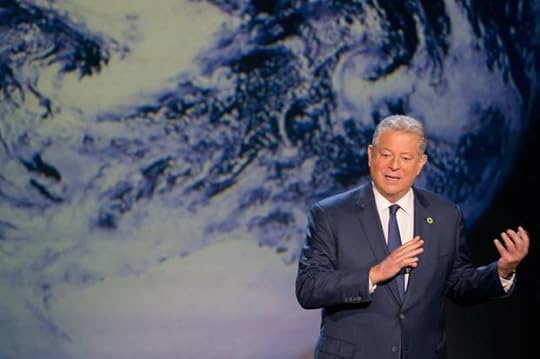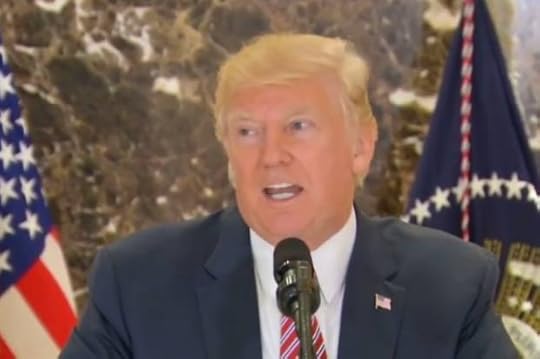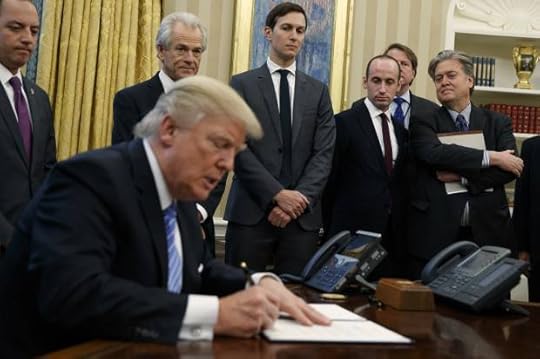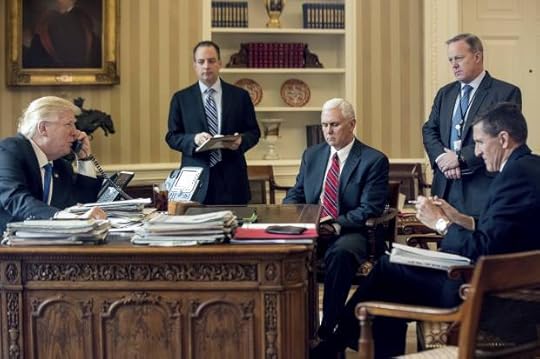Helen H. Moore's Blog, page 330
August 15, 2017
“An Inconvenient Sequel” is good science with a fuzzy agenda

Al Gore giving his updated presentation in "An Inconvenient Sequel: Truth To Power" (Credit: Paramount Pictures/Jensen Walker)
As I prepared to see “An Inconvenient Sequel,” my friends Jon and Chris and girlfriend Fran joked about Al Gore’s numerous appearances in pop culture, from direct cameos (“Futurama,” “30 Rock”) to satirical jabs (“South Park,” “Saturday Night Live”).
After the movie was over, the four of us were still discussing Gore’s pop culture appearances. And that, more than anything else, is the chief failing of the film.
Of course, this isn’t what the purveyors of pseudo-science would have you believe. Pundits like The Daily Caller’s Michael Bastasch have been claiming that the global warming observations and predictions from “An Inconvenient Truth” ultimately “never came true” and have used that claim to smear Gore’s new documentary about man-made climate change.
As has long been the case with the anthropogenic global warming deniers, however, their argument depends on disregarding the expertise of top scientists.
“Everything is heading in the direction of what Gore pointed out in ‘An Inconvenient Truth,'” said Ken Caldeira of the Carnegie Institution for Science. “It might take us a little longer to get there than he suggested, but we will end up in the same place if we don’t do something about our greenhouse gas emissions.”
As Caldeira also explained earlier in his email to Salon, the various points cited by conservatives as discrediting Gore’s earlier film actually reinforce his point about global warming. There has been a significant ice retreat on Mount Kilimanjaro over the past century, despite right-wing claims to the contrary; Arctic sea ice has plummeted since 1979, again despite conservative attempts to spin that fact; and although Bastasch insists there has been a global warming “hiatus,” in fact “the last 3 years were the hottest 3 years on record, and the 15 years of the ‘hiatus’ were the warmest 15 years on record.”
And, of course, there is that timeworn claim that Gore and the scientific community are predicting an ice age. “They are apparently watching ‘The Day After Tomorrow’ and confusing it for ‘An Inconvenient Truth,'” Caldeira wrote. “‘An Inconvenient Truth’ did not predict that global warming would predict an ice age.”
Kevin Trenberth, of the Climate Analysis Section at the U.S. National Center for Atmospheric Research (NCAR), made similar observations to Salon. After noting that he did not recall Gore making specific predictions in his first film and that if he did “any such predictions are posed as risks,” he pointed out that man-made climate change costs billions of dollars in damage each year; that “glaciers are melting worldwide and the snow season is a lot shorter”; and that “heat waves have indeed increased and caused huge losses.” Trenberth also echoed many of Caldeira’s observations before closing by stating that “Al Gore’s warnings hold true today every bit as much as before.”
This isn’t to say that scientists are brimming with enthusiasm for “An Inconvenient Sequel.” As Trenberth also mused in his email to Salon, “Whereas ‘An Inconvenient Truth’ seemed to be more about climate change, with Al Gore as a star, this movie seems to be about Al Gore, with climate change playing a secondary role.”
I couldn’t have put it better myself. While both films in Gore’s “Inconvenient” series go into detail about the former vice president’s biography, the insertions seem more egregious in the sequel than the original. With “An Inconvenient Truth,” the bulk of Gore’s intelligence, wit and passion was invested in breaking down climate science in such a way that the vast majority of viewers could easily understand the threat presented by man-made global warming.
The tensest and most exciting moments of “An Inconvenient Sequel,” by contrast, are those in which Gore is front and center. In particular, we see the 2000 Democratic presidential nominee wheel and deal with Indian power-brokers to obtain that nation’s support for the 2015 Paris climate accord. This is interesting and relevant material, of course, but the narrative often seems to focus more on promoting Gore as a hero than on impressing upon its audience the dire need for change.
Strangely enough, this creative decision would be more justifiable if Gore was running for president in 2020 (he makes it clear in the documentary that this is not the case). Just as Bernie Sanders was able to draw increased attention to the issue of income inequality through his 2016 presidential bid, so too could Gore quite literally change the world by running for president with a focus on global warming (a point I’ve made in the past). If “An Inconvenient Sequel” was meant to be the kickoff for a Gore 2020 campaign, its focus on Gore himself would make perfect sense. Barring that possibility, however, it simply muddles the film’s purpose, if not its message.
Would I still recommend “An Inconvenient Sequel”? Sure, although I doubt there is much one could glean from this movie that couldn’t be obtained by rewatching “An Inconvenient Truth.” The thing about science is that it doesn’t much care for the flawed human beings who try to interpret it. Man-made global warming will continue to threaten our species whether we admit it or not, and that reality remains as present in 2017 as it did in 2006.
There are worse ways to learn about this subject than to watch “An Inconvenient Sequel.” It’s just a shame that Gore didn’t come up with a better one either.
Love live storytelling? These 8 podcasts tell the good, bad and mortifying truth

(Credit: Getty/RapidEye)
It’s electric: these eight podcasts capture the storytellers’ adrenaline as they step into the spotlight to tell their tales. From the shocking to the sweet to the embarrassing, these live stories are told for an audience of you.
1. “The Moth”
Featuring favorite stories from live Moth events around the country.
2. “Snap Judgment”
A weekly radio hour of dramatically told stories with killer beats.
3. “Risk!”
Jaw-dropping and uncensored true stories that are remarkably real.
4. “2nd Story”
Fusing page, stage, and sound into a literary and theatrical experience that builds community through storytelling.
5. “RadioWest Podcasts”
Conversations between people that explore the way the world works
6. “The Stoop Storytelling Series”
Weird, wonderful, hilarious, heartbreaking — and, above all, intimate stories from ordinary people telling extraordinary true tales.
7. “Mortified”
Sharing the most embarrassing things created in our childhood — in front of total strangers.
8. “Grownups Read Things They Wrote as Kids”
Remembering the good, the bad, and the awkward parts of growing up.
Live storytelling is a part of the Arts podcast collection on RadioPublic . For more audio collections like this, check out RadioPublic’s guide . Begin listening to the most recent episodes here, or download the RadioPublic app for iOS or Android to follow the shows from any of these links.
Can comedy save us in the “post-truth” era?

In her fascinating, comprehensive new book “The Girl in the Show: Three Generations of Comedy, Culture, & Feminism,” author Anna Fields reveals the audacious women who shaped modern comedy — and the obstacles they overcame just to get a place on the stage to make audiences laugh. Culled from both exhaustive research and interviews with luminaries like Abbi Jacobson and Molly Shannon, it’s a tribute to the power of women standing up.
Fields spoke recently with Salon about comedy and the “girls” in the rooms where it happened.
On the presumed masculinity of humor:
We do think of men when we think of comedy, and we do think of maleness when we think of a comedian. So many of the women I interviewed talked to me about how they have to “trick the audience into thinking they’re men” in order for the audience to feel comfortable laughing at them but also loving them.
It’s so fascinating — what is a comedian supposed to look like?
On how gender fluidity is changing comedy:
What is to be a female comedian? What is it to be a male comedian? What if you are a comedian of either, both, or no gender? What does that mean in terms of how you present yourself to the audience, what you are allowed to joke about, and whether your audience will feel comfortable joking with you about that thing?
On the political power of laughter
I’ve always asked myself if, given that we live in an era in which so many of our leaders are abdicating their role as truth tellers, if comedians, by telling us the truth, become our new national leaders?
Watch the video for more of our conversation about women and comedy.
Trump’s defense of Confederate memorials echoes Daily Stormer, Fox News

“Are we going to take down statues to George Washington?” President Donald Trump asked to defend Americans who want to keep memorials to the Confederacy. Days after deadly clashes rocked Charlottesville, Virginia, and the nation, the president echoed language used frequently by white nationalists.
“Many of those people were there to protest the taking down of the statue of Robert E. Lee,” Trump said in reference to the protest last Saturday organized by white nationalists which saw widespread acts of violence and even the death of a woman who was there to protest against American fascism.
“So this week it’s Robert E. Lee, I noticed that Stonewall Jackson is coming down, I wonder: is it George Washington next week? And is it Thomas Jefferson the week after?” Trump asked. “You really do have to ask yourself, where does it stop?”
Trump continued, claiming that removing memorials to treasonous Confederate generals was the equivalent of attacking monuments to American founders who owned slaves. People who want to remove such monuments need to realize that to some people, the Lee memorial in Charlottesville was, according to Trump “a very, very, important statue.”
“You’re changing history, you’re changing culture,” Trump warned. He also argued that there were “many people” who attended the rally who were not neo-Nazis and white nationalists. While there may have been some attendees who did not fit that description, the only speaker’s rally organizers mentioned in their final promotional materials were self-described racists. “If you look, they were people protesting very quietly the taking down of the statue of Robert E. Lee,” Trump said of tiki torch-wielding white nationalists who stormed the University of Virginia Friday night.
The president’s sentiments on the matter of Confederate statues and memorials to Founding Fathers were literally an echo of an article written earlier today by the neo-Nazi website The Daily Stormer. (The website has since gone offline.) Referring to some demonstrators in Durham, North Carolina who took down a Confederate statue, Andrew Anglin, the site’s owner wrote:
“I guarantee you, they are going to go to Washington, and they are going to demand that the Washington Monument be torn down. They might even try to pull it down. Because George Washington owned slaves. More importantly, he was a white man who built something.”
A similar argument has been made multiple times on Fox News in recent days. On Monday, former House Speaker Newt Gingrich asked, “What if you weren’t sensitive enough to the Holocaust, we should take down all the statues of Franklin Delano Roosevelt? You could make an argument for that.”
Fox News host Matha MacCallum responded, “You could make an argument for Thomas Jefferson or George Washington. Are you going to change the name of the Washington Monument?”
Tuesday morning, on Trump’s favorite show, “Fox & Friends,” guest and rumored new Fox News host Laura Ingraham asked, “How long before they show up at Monticello, where I spent three years in law school at Charlottesville in Virginia? How long before they show up at Mount Vernon?”
“Or Mount Rushmore,” added co-host Pete Hegseth.
Shortly before Trump’s news conference, Politico reported that the president on Saturday had deliberately rejected pre-prepared remarks about the violence in Charlottesville which had specifically condemned white nationalists. Instead, he chose to condemn violence “on many sides.”
Several news reports have suggested in recent months that Trump’s defensive posture toward criticism of individuals many would perceive as racist is the product of a political calculus recommended to him by his top adviser, former Breitbart News chairman Steve Bannon.
During his Tuesday remarks, Trump argued that people should condemn the “alt-left,” a collection of people who he said were “very violent” and who engage in acts of assault against conservatives.
The Grand Old Party’s over. Make way for the Trump Party

(Credit: AP Photo/Evan Vucci, File)
You’ve probably heard the story. It’s said that in ancient Rome, the emperor had a member of the Praetorian Guard who, amid all the pomp and all the accolades, would stand behind him and murmur: “Remember, Caesar, thou art mortal.”
Sadly, the Little Caesar who currently rules the United States from the nearest Trump golf course is instead surrounded by guards who murmur enthusiastically, “Anything you say, boss. You’re a genius!”
The new chief of staff, Marine vet John Kelly, allegedly was supposed to rein this kind of stuff in, but while the meetings now may run more smoothly, his boss continues tweeting any nonsense he hears from “Fox & Friends,” declares himself pretty much the greatest president ever and casually threatens to start lobbing missiles at North Korea because he seems to think it would be cool to see what a thermonuclear fireball looks like. Locked and loaded indeed.
VICE News reported on Tuesday, “Twice a day since the beginning of the Trump administration, a special folder is prepared for the president…
These sensitive papers, described to VICE News by three current and former White House officials, don’t contain top-secret intelligence or updates on legislative initiatives. Instead, the folders are filled with screenshots of positive cable news chyrons (those lower-third headlines and crawls), admiring tweets, transcripts of fawning TV interviews, praise-filled news stories, and sometimes just pictures of Trump on TV looking powerful.
You can’t make this stuff up. One glimmer of hope in all this pandemonium is that more and more, some Republican members of Congress finally seem willing to challenge their misbegotten king. Witness, for example, the three GOP senators standing up against the health care travesty, the opposition to rumors of Trump firing Attorney General Sessions or special counsel Mueller and the overwhelming passage of new sanctions against Russia — legislation Trump was forced to sign although it clearly gave him a conniption.
Even Senate Majority Leader Mitch McConnell, that staunchest of company men, told the crowd at a Rotary Club meeting back home in Kentucky this week that he thinks Trump doesn’t understand how Congress works, and “had excessive expectations about how quickly things happen in the democratic process, and so part of the reason I think people feel we’re underperforming is because of too many kind of artificial deadlines unrelated to the reality of the complexity of legislating.”
This quickly prompted belligerent comments from Trump and a volley of poison pen tweets taunting the Senate’s inability to repeal Obamacare, starting with this one:
Senator Mitch McConnell said I had “excessive expectations,” but I don’t think so. After 7 years of hearing Repeal & Replace, why not done?
— Donald J. Trump (@realDonaldTrump) August 9, 2017
Meanwhile, The New York Times reported over the weekend that “President Trump’s first term is ostensibly just warming up, but luminaries in his own party have begun what amounts to a shadow campaign for 2020 — as if the current occupant of 1600 Pennsylvania Ave. weren’t involved.
The would-be candidates are cultivating some of the party’s most prominent donors, courting conservative interest groups and carefully enhancing their profiles. Mr. Trump has given no indication that he will decline to seek a second term.
The “sheer disarray surrounding the presidency” has “prompted Republican officeholders to take steps unheard of so soon into a new administration.” That includes Vice President Mike Pence, who The Times notes already has set up a fundraising committee and hired a new chief of staff with more experience running campaigns than governing.
The Times piece created such a stir that Pence immediately denounced it as “disgraceful and offensive to me, my family, and our entire team,” prompting The Washington Post to ask, why did the story make the vice president so hot and bothered? What is he so touchy about? Hmmm . . .
The fact is, the catastrophe that the Republican Party has brought down on itself with this president is of such a magnitude that it may never recover, even if Mike Pence ends up taking over ahead of schedule. Party leaders are looking at Trump’s poll numbers (plus a Real Clear Politics generic poll that shows Americans now favoring a Democratic Party-controlled Congress by almost 9 points). And they’re experiencing the genuine dysfunction at both ends of Pennsylvania Avenue.
So far, the few GOP higher-ups who publicly have expressed concern about all this seem to have done so more out of frustration and expedience than principle. The one exception would appear to be Arizona’s US Sen. Jeff Flake, who made a splash the last couple of weeks with his book, “Conscience of a Conservative,” a title appropriated from a famous tome by Barry Goldwater back in the ’60s.
“Never has a party so quickly or easily abandoned its core principles as my party did in the course of the 2016 campaign,” Flake writes.
And when you suddenly decide that you don’t believe what had recently been your most deeply held beliefs, then you open yourself to believing anything — or maybe nothing at all. Following the lead of a candidate who had a special skill for identifying problems, if not for solving them, we lurched like a tranquilized elephant from a broad consensus on economic philosophy and free trade that had held for generations to an incoherent and often untrue mash of back-of-the-envelope populist slogans.
The choice of Trump as candidate and president was a “Faustian bargain,” Flake declares:
We have given in to the politics of anger — the belief that riling up the base can make up for failed attempts to broaden the electorate. These are the spasms of a dying party. Anger and resentment and blaming groups of people for our problems might work politically in the short term, but it’s a dangerous impulse in a pluralistic society, and we know from history that it’s an impulse that, once acted upon, never ends well.
Yet as Esquire’s Charlie Pierce and others have pointed out, despite Flake’s rhetoric, he has voted with the Trump agenda, such as it is, 95 percent of the time.
But that doesn’t wash with this president; Flake has mouthed off and now must sleep with the fishes (remember, too, that Flake refused to endorse Trump’s candidacy).
The president has encouraged a primary challenge to Flake and met with three contenders. What’s more, Robert Mercer, the hedge fund billionaire who contributed heavily to the Trump campaign, is giving $300,000 to a super PAC backing Flake opponent Kelli Ward.
(You’ll recall that Dr. Ward recently suggested that cancer-stricken John McCain, to whom she lost a 2016 primary, should “step away as quickly as possible” and resign from the Senate. She added that she hoped the governor would consider appointing her to fill out McCain’s term. Classy.)
Republicans should forget about any White House loyalty to the party, especially now that Reince Priebus is gone. Trump has none — witness not only his attacks on incumbent senators Flake and McConnell but on any Republican not toeing the line or groveling in his general direction. Also note how he refers to Republicans as “they” and “them,” not “we.”
Plus, there’s a set of poll numbers he sees, too — as unpopular as he is, voters like Congress even less. According to a new CNN poll, “only about a quarter of all Americans (24 percent) judge the Republican Congress a success so far. President Trump gets the approval of 38 percent of Americans.”
Even as he mocks them, most of Republican leadership continues to grovel at the Trump shrine as they hope to continue the “sugar high,” as Jeff Flake calls it, that carried them to victory last year and which they keep thinking will advance their moribund agenda. But Trump’s base may not be buying it and already is turning on them. Trump sees this and will seize upon it as any opportunistic creature does with easy prey. Add to this lust for self-preservation an ego the size of a planet that takes credit for everything and blame for nothing.
And so, this scenario: Within months, Donald Trump has so riven the GOP that there is no unity left among Republicans except for those who see him as the second coming. Party members who attempt to field a Never Trump movement are as hapless as they were in 2016 and provide only token opposition to the careening Trump steamroller, despite its ever-expanding catalogue of catastrophe. If he hasn’t been drummed out of office, the Donald abides.
But Trump has no use for Republicans anymore, even if they provide him cover on Capitol Hill and a network of connections to deep pockets. He will announce the creation of a third party that will drumbeat for the re-election of Trump/Pence, incite the base and field its own slate of congressional candidates in 2020, perhaps even as soon as 2018.
It will, of course, be called the Trump Party.
You’ve been warned.
Why didn’t sanctions stop North Korea’s missile program?

Kim Jong-Un (Credit: KRT via AP Video)
North Korea’s long-range missile program has made significant technological advances in the past few months.
For most of the past 20 years, the international community has struggled to stop this kind of progress.
Kim Jong Un’s plan to target four test missiles approximately 20 miles off the coast of the U.S. territory of Guam shows just how destabilizing this rapidly advancing ballistic missile program can be. North Korea’s plan — which Kim claims will be finalized later this month — follows last month’s two successful tests of an intercontinental ballistic missile with the capability to hit the U.S.
My research on how states illegally obtain missile technologies and my experience conducting outreach related to U.N. sanctions give me some insight into the methods North Korea used to make illicit procurements and the limitations in using technology-based sanctions to prevent them.
Technology-based sanctions
In 2006 — following North Korea’s first nuclear test — the U.N. Security Council prohibited the “supply, sale or transfer” of “items, materials, equipment, goods and technology” that could contribute to the country’s missile program.
Efforts to prevent North Korea’s acquisition of missile technology by certain nations — notably the United States — had been underway since the 1990s. However, the U.N. sanctions went further by placing standardized legal requirements on all states to prevent the development of North Korea’s weapons of mass destruction programs.
These sanctions are “universal” — obligatory for all states around the world. Each nation is responsible for implementation within its borders. Missile, nuclear and military technologies are regulated through national export control systems. Exports of certain goods and technologies need to be granted an export license by the government. This allows governments to do a risk assessment on transactions and minimize the diversions to undesirable uses, such as Weapons of Mass Destruction programs or human rights abuses.
In theory, all countries should have the capacity to implement technology-based sanctions. Having an export control system has been mandatory for states since the passage of U.N. Security Council resolution 1540 in 2004. However, more than a decade after this resolution was passed, many nations — particularly developing ones — are still struggling with implemention.
This has led to uneven execution of missile-related sanctions on North Korea. A recent report has described the U.N. sanctions regime as a “house without foundations,” noting that not a single element of the sanctions regime “enjoys robust international implementation.”
Sources of missile technology
As North Korea’s missile program has advanced, its sources of missile technology have evolved.
North Korea began by importing full missile systems and seeking to reverse-engineer or replicate them. For example, after procuring short-range Scud missiles from Egypt in the late 1970s, North Korea “reverse-engineered” them by the mid-1980s. The 1990s saw North Korea develop the Nodong, a scaled-up Scud design. It also experimented with longer-range missiles in the late 1990s and mid-2000s. These Taepodong missiles drew together elements of the shorter-range systems such as their engines. The Taepodong-2 allegedly had an intercontinental range, although it was never successfully tested.
Since taking power in 2011, Kim Jong Un has accelerated North Korea’s missile program. In the past year alone, the country has tested four seemingly new missiles for the first time — including a submarine-launched ballistic missile and an intermediate range ballistic missile, as well as the ICBMs tested last month.
The country has also sought to learn how to produce required parts and components at home. North Korea’s program is opaque, and the balance between reliance on external sources and homemade parts is unclear, but some episodes provide insights.
Rocket debris salvaged from the sea following a satellite launch in December 2012 suggested an ongoing reliance on the international market place for parts. A 2013 U.N. report suggested the rocket had used modern components sourced from China, Switzerland, the U.K. and the U.S., as well as “cannibalized” Scud components and other 1980s vintage Soviet parts.
Since then, North Korea has continued to pursue more advanced manufacturing technologies. Footage from the leadership’s frequent factory visits has shown that North Korea has acquired advanced computer numerically controlled machine tools which are of use in missile and nuclear programs. Photographs from a parade in April 2017 suggest that North Korea’s new submarine-launched ballistic missile was constructed with wound filament. This material is lighter and stronger than aluminum, and a significant step forward in capability.
Evading sanctions
To make these advances in their missile program, North Korea has had to evade sanctions and the broader scrutiny of the international community. Their illicit procurement techniques include using front companies, obscuring the end user, falsifying documentation and mislabeling cargo. A 2017 U.N. report notes that North Korea’s evasion techniques are “increasing in scale, scope and sophistication.”
North Korea’s military and WMD procurement networks are global in nature. According to one study, they have touched more than 60 countries.
Due to geographical proximity, historic relationship and broader trading links, China has played an unparalleled role in these networks. Many middlemen and procurement agents have operated in China, and increasingly — as the country’s private sector develops — its manufacturers have been a source of technology. A series of revelations in early 2017 demonstrated that Chinese manufacturers and Chinese-North Korean joint ventures are benefiting North Korea’s missile program — including with machine tools, components and materials.
The effects of sanctions?
Observers might rightfully ask: Have sanctions failed?
This question is complicated. It might be more useful to consider what the effects of sanctions have been.
The primary objectives of technology-based sanctions have been to slow and prevent North Korea’s nuclear and missile development. The recent ICBM tests clearly prove these measures have not prevented North Korea’s missile development. Whether they slowed progress is debatable.
What is undeniable is that sanctions have had unforeseen consequences. Research suggests that sanctions could have made North Korea’s procurement efforts more sophisticated as Chinese middlemen monetize the risk.
Americans tend to view North Korea as an inward-looking, economically isolated state cut off from the international community. However, the country’s illicit networks — including those supplying its missile program — are global and responsive. Ultimately, they will be difficult to counter.
 This is an updated version of an article originally published on July 7, 2017.
This is an updated version of an article originally published on July 7, 2017.
Daniel Salisbury, Postdoctoral Fellow, Middlebury Institute of International Studies at Monterey
He ruins everything: Trump is having a negative effect on the workplace

FILE - In this Jan. 28, 2017, file photo, President Donald Trump accompanied by, from second from left, Chief of Staff Reince Priebus, Vice President Mike Pence, White House press secretary Sean Spicer and National Security Adviser Michael Flynn speaks on the phone with Russian President Vladimir Putin in the Oval Office at the White House in Washington. (Credit: AP Photo/Andrew Harnik, File)
For better or for worse, American presidents influence U.S. culture. In the case of Donald Trump, it’s undoubtedly for the worse. The man who currently occupies the White House lies without hesitation, insults those he perceives as threats, brags about committing sex crimes against women, advocates for violence, and pushes racist and xenophobic untruths. His poisonous leadership has created a toxic atmosphere that permeates every aspect of American society. This includes the workplace, according to the findings of a recent survey.
Nearly 46 percent of Americans believe that “the brutish 2016 election campaigns negatively impacted the workplace,” according to the Workplace Bullying Institute. In an abstract subtitled “Trump Toxicity,” the organization notes that as a candidate, Trump “modeled bullying and [gave] license for others to forego norms of interpersonal civility and kindness.” The trickledown effect is leading to increasingly inhospitable workplaces and an increase in inappropriate behavior.
“It violates all the norms and the niceties of how one should behave,” Gary Namie, the head of the Workplace Bullying Institute, told Martha C. White of NBC News. “What it’s exposing is the very, very dark side of our society.”
White spoke to human resources staffers and workplace leaders who report observing the effects of Trump Toxicity among colleagues. They note an increase in Trump-reminiscent behaviors, “from dropping f-bombs to fudging details on resumes to spreading false rumors about co-workers, all of which stifles teamwork, dampens morale, and hurts productivity.”
Mike Letizia, the president of Letizia HR Solutions, told White he’s recently had to explain to his employees that Trump’s highly unpresidential behavior shouldn’t be replicated in the workplace (even though 63 million people believed it belonged in the White House).
“Within my circle of clients there have been some behavioral changes on the part of employees. It has become more challenging for HR people to deal with some of the interpersonal behaviors that have come out,” Letizia told White. “We’ve had to do a lot more . . . talking to employees about the fact that the U.S. government and current administration in Washington, D.C. does not set the standard for professional behavior in the workplace.”
The consequences of electing a brash bully who publicly disrespects even his closest advisers, creates a daily disruption in the news cycle and punches down at every opportunity have already been visible in plenty of other areas.
“Trump is serving as a negative kind of role model,” Seth Spain, a professor at John Molson School of Business at Concordia University, told White. “They see his behavior, they see that it worked, it was effective, and use that as a model.”
The Trump administration’s hateful rhetoric toward racial, religious and other vulnerable groups is directly related to a documented rise in violent hate crimes. Emboldened by Trump, white nationalist groups have proliferated since last year. A Buzzfeed review of bullying incidents in elementary, middle and high schools around the country found a pattern of “white students using the president’s words and slogans to bully Latino, Middle Eastern, black, Asian, and Jewish classmates.”
While the Workplace Bullying Institute survey didn’t specifically highlight Trump’s impact on workplace incidents involving racism or sexist harassment, it does note that there are vast disparities in precisely who is bullied in work spaces. Seventy percent of workplace abusers are men, while 66 percent of targets are women. African Americans and Hispanics are also bullied at higher rates than their peers. Any rise in bullying behaviors will have a disproportionate effect on women of all races and people of color.
Despite touting himself as the savior of business, Trump’s toxicity incurs all kinds of costs to companies. There’s the obvious human cost of having people feel unwelcome and even unsafe at work. But the problem also affects efficiency, which directly impacts the bottom line.
“The time it takes to address those situations takes away from other work to move strategic initiatives forward,” Robert Farmer, a member of the Society for Human Resource Management, told White. “From there, it’s going to start to impact productivity and performance.”
“With more turnover, the cost to train people multiplies. You have to pay a lot more to recruit and train people so they can be productive employees,” career counselor Roy Cohen added.
Bloomberg notes that in response to workplace fallout from Trump’s election, there’s been “an uptick in employers and in-house counsel requests for civility training, as recommended by the Equal Employment Opportunity Commission’s proposed guidance on harassment.”
“Civility in the workplace really just boils down to clear, mindful and ethical communication,” said Maria Greco Danaher, who counsels HR departments and corporate management. “We’ve been treating post-election negative speech as a problem, but I think we’re being faced with an opportunity and an eye-opener that could really help us to use clear communication and mindful communication in a way to make businesses run more smoothly and make workplaces feel more efficient and effective to the people that are in them.”
Sure. It’s also a chance to send a clear message to workplace jerks that just because their president is a boorish ass doesn’t mean they can start pulling that stuff at work. Or something like that.
August 14, 2017
Ultimate clean-slate handbook

(Credit: Getty/dolgachov)
We tell our kids that everyone makes mistakes — and we mean it — but if the last year was a rough one, it can be hard to bounce back. Past struggles with grades, organization, and friends are easy to carry over into the new year. Even determined kids may find themselves playing out the same patterns, engaging in the same old conflicts, or stuck in last year’s situations.
While there’s rarely one answer to a kid’s struggles — and there’s no substitute for open communication — sometimes media can offer a fresh approach to old problems. And if your kids really want to change course, finding what works for them can be a real self-esteem booster.
These books, apps, and websites can help kids gain perspective, as well as practice positive habits around communication, time management, self-regulation, and organization. Check out our Homework Help Apps, Time Management Apps, and Note-Taking Apps for Tweens and Teens for even more ideas.
Get organized
Do you need a hazmat suit to explore your kid’s backpack? Does note taking mean scribbling three sentences across a page? Does “I’ll do it tomorrow” really mean, “I already forgot what you said”? Use some tools to create a new routine.
Choiceworks Calendar. 8+
With lots of visuals to choose from, this planner empowers kids to organize their time.
30/30. 10+
Use this timer to help kids break larger tasks into smaller ones.
SoundNote. 14+
Because kids can sync audio with written notes, this app can help kids get information in multiple ways and keep them organized.
Study smarter
Press the reset button on study habits with some tools that might help build necessary skills.
GeoWalk HD – 3D World Fact Book. 8+
Kids can explore a wide variety of facts in bite-sized, visually appealing chunks.
BrainPop. 10+
Videos and animated content serve up lots of educational information.
Yup – homework help with Math & Chemistry Tutors. 13+
Through the app teens can contact qualified tutors who will walk them through problems step-by-step.
Communicate clearly
Smooth out the rough edges with some social-skills practice that will help make a fresh start.
The Social Express II. 8+
This game helps kids understand the “hidden rules” of social communication and includes a social network.
LikeSo. 11+
When kids need to tone down teen-speak for formal presentations, this app tracks words and phrases they’d rather omit.
ConversationBuilder Teen. 13+
Through scripts and situations, kids can practice their communication choices.
Forge positive friendships
Leave the drama behind with social networks that encourage positive interaction.
Yoursphere. 9+
This social network is a safer starting place for younger users who want to practice their digital citizenship skills.
Kidzworld. 11+
Short articles, social networking, and self expression come together on this kid-friendly site.
Sit With Us. 13+
Created by a teen, this app helps kids find friends (and a place at a lunch table) without the risk of public humiliation.
Reflect and reframe
Put things in perspective and remind kids they aren’t alone through the pages of these books.
About Average. 8+
This anti-bullying book can help empower kids to seek solutions.
Addie on the Inside. 11+
Told through poetry, Addie’s story covers a lot of emotional ground and features a brave female protagonist.
King Dork. 15+
This realistic coming-of-age book is a relatable read for teens who don’t love high school.
Boost self esteem
Widen kids’ focus to helping others and creating a purpose outside of school.
New Moon Girls Online. 10+
Kids can publish and post through this girl-focused, moderated site.
Youth Service America. 13+
This website connects teens with service experiences and lets them share through blogs and videos.
Charity Miles – Running & Walking Distance Tracker. 13+
As kids exercise, they also earn money for their chosen charities.
If we keep subsidizing wind, will the cost of wind energy go down?

In this Thursday, April 13, 2017 photo, a truck drives by wind turbines near Okarche, Okla. Gov. Mary Fallin is expected to sign legislation Monday, April 17, that rolls back a 10-year tax credit for electricity generated by zero-emission facilities, an incentive for wind power generators as well as geothermal, solar and hydropower producers that’s been in place since 2003. (AP Photo/Sue Ogrocki) (Credit: AP)
There are high hopes for renewable energy to help society by providing a more stable climate, better energy security and less pollution. Government actions reflect these hopes through policies to promote renewable energy. In the U.S. since 1992 there’s been a federal subsidy to promote wind energy, and many states require electricity utilities to use some renewable energy.
But when is the right time to stop government support for an energy technology?
This is a timely question: Rick Perry’s Department of Energy is currently working on a grid reliability report that many expect to argue that wind and solar cause reliability problems because they don’t supply power continually. A conclusion like this can be used to justify removal of government subsidies or regulations favoring other sources of energy.
Subsidies need not last forever — there can come a time when its objective has been achieved or experience suggests the subsidy is not working as intended.
Is it time to end subsidies for wind? A big part of the answer to this question lies in whether subsidies are actually making wind cheaper.
Why subsidize energy technology
The justification for subsidizing a given technology is that it delivers public benefits that outweigh the subsidy cost. If a technology shows promise to become cheap enough, the subsidy can be viewed as a temporary stimulus to bring it a point where it can stand on its own.
For example, in the early days of the semiconductor industry, integrated circuits were too expensive for consumer markets. Government demand for military applications provided a critical bridge to bring down costs and activate broader markets.
On the other hand, subsidizing an emerging technology that has trouble bringing down costs may be inefficient. For decades, the U.S. government has subsidized or mandated production of corn ethanol. Yet ethanol is still not market-competitive, at least not with recent crude oil prices.
Wind power’s ‘learning curve’
The price for wind power has gone down over the years, but how cheap is it getting? There is a surprisingly diverse set of answers to this question. There are over 100 existing studies of wind cost trends, with results ranging from wind power becoming more expensive over time to becoming cheaper so quickly that it will soon be cheaper than fossil fuels. Curiously enough, while researchers have recently started to note disparities between studies, no one has yet grappled with explaining and reducing such variability. This is, unfortunately, a common situation in many research domains: Various groups get conflicting results from similar analyses, but no one works on understanding why these differences arise.
In a recent paper, we sought to better understand cost reductions in wind power by finding patterns in historical trends.
Wind costs follow what economists call a learning curve: For every doubling of wind production, the cost goes down by a fixed percentage. For example, if the price of electricity from wind is 10 cents per kilowatt-hour with a given number of wind farms, a 10 percent “learning rate” means that wind electricity would cost 10 percent less, or 9 cents per kilowatt-hour, if one doubles the number of wind farms.
Our main finding was that the learning rate for wind power is in the range of 7.7 percent to 11 percent. That means if more wind power is installed and the cost of energy continues to decline as it has in recent years, the cost of generating electricity with wind will fall from 5.5 cents/kilowatt-hour today to 4.1–4.5 cents/kilowatt-hour in 2030.
Previous studies obtained learning rates from -3 percent to +33 percent, the minus sign indicating wind becoming more, rather than less, expensive over time. Why are the results so different? We showed that one can get very different outcomes depending on the method and data range used.
First, we believe it is important to account for wind power costs in terms of the total cost to generate electricity. Many prior studies measured wind cost as the price to build the capacity to make electricity at peak wind times. But this is a poor measure because much of the progress in wind technology in recent years has been to generate more power when the wind is weaker.
Secondly, it is important to treat wind power as a global industry. The adoption of wind in one country helps the industry develop and grow so that wind becomes cheaper in other countries. Modeling wind adoption in only one nation can skew results.
Finally, results depend strongly on the date range of data used. Even with an identical method, the estimated learning rate can change up to 10 percent depending on which years of data you use.
To subsidize or not to subsidize?
So if wind costs will fall to 4.1–4.5 cents/kilowatt-hour in 2030, as we found, what does this mean for wind subsidies? The U.S. Energy Information Agency projects the cost of natural gas and coal power in 2030 will be 4.5 and 5 cents per kilowatt-hour respectively. Taking these numbers at face value, wind is on track to become cheaper than fossil fuels as a source of electricity.
One must be cautious, however, in feeling too sure of forecasts. Technologies and fuel prices can go in unpredictable directions. Also, wind is an intermittent resource, meaning it can’t provide round-the-clock power as fossil fuels can. There is an additional cost to this intermittency, which is very difficult to predict.
Also, being cheap doesn’t mean we will soon be able to switch to 100 percent wind. To meet electricity demand continually, we will need a combination of energy storage, lowering power consumption at certain times (known as demand response) and traditional “firm” power production.
This said, the past suggests a trajectory in which wind becomes economically competitive with fossil fuels. Our study shows that support policies, such as the current Production Tax Credit, are contributing to lowering wind costs. As such, continued subsidies are expected to enable a smoother and cheaper transition to a sustainable energy system.
Eric Williams, Associate Professor of Sustainability, Rochester Institute of Technology and Eric Hittinger, Assistant Professor of Public Policy, Rochester Institute of Technology
These are the crazy climate records from 2016 you haven’t heard much about

In this June 15, 2014 photo, a polar bear dries off after taking a swim in the Chukchi Sea in Alaska. (Credit: AP Photo/U.S. Geological Survey, Brian Battaile)
By now, we’ve all heard that 2016 was the hottest year on record, and that heat-trapping greenhouse gases hit their highest concentration ever, surpassing 400 parts per million for the first time in nearly 1 million years.
But there are other climate change-related records that have flown more under the radar. Several of those records were highlighted Thursday in the annual State of the Climate report, released in the Bulletin of the American Meteorological Society:
For example, during August, ice-free areas of the Barents Sea (north of Norway and Russia) were up to 20°F (11°C) above average, a figure that stunned climate scientists.
The Chukchi Sea off Alaska and the waters to the west of Greenland were 13°F to 14°F above average. Those warm waters were linked to the smallest annual winter peak in sea ice levels and the second lowest annual minimum.
The average land surface temperature for the Arctic was 3.6°F (2.0°C) above the 1981-2010 average — a 6.3°F (3.5°C) rise in temperatures since 1900. Record-high temperatures were measured below the surface of the permafrost, or permanently frozen ground, across the North Slope of Alaska.
“2016 was a year in the Arctic like we’ve never seen before,” Jeremy Mathis, director of the National Oceanic and Atmospheric Administration’s Arctic research program and an author of the report, said.
The rate of warming in the Arctic, which is happening at twice the rate of the rest of the globe, has major impacts on local ecosystems, but also further drives the warming of the planet, as the sea ice that would reflect the sun’s rays back to space is lost.
And for the 37th consecutive year, alpine glaciers retreated across the globe. These glaciers are a major source of water for local communities, and their loss has led to concerns about water security, particularly in places like Southeast Asia.
Global sea level was also the highest on record — and sea surface temperatures globally were also record-high — with a sea level 3.25 inches higher than they were in 1993, the beginning of the record. The year marked six consecutive years of global sea levels being higher than the year before. Over the long term, sea level rise is driven by the warming of the oceans (as water expands as it heats up) and the addition of water from melting polar ice.
On a more local level, the year, which was the second hottest on record for the U.S., was the 20th consecutive warmer-than-normal year for the country — a mark of the impact that long-term warming is having.





